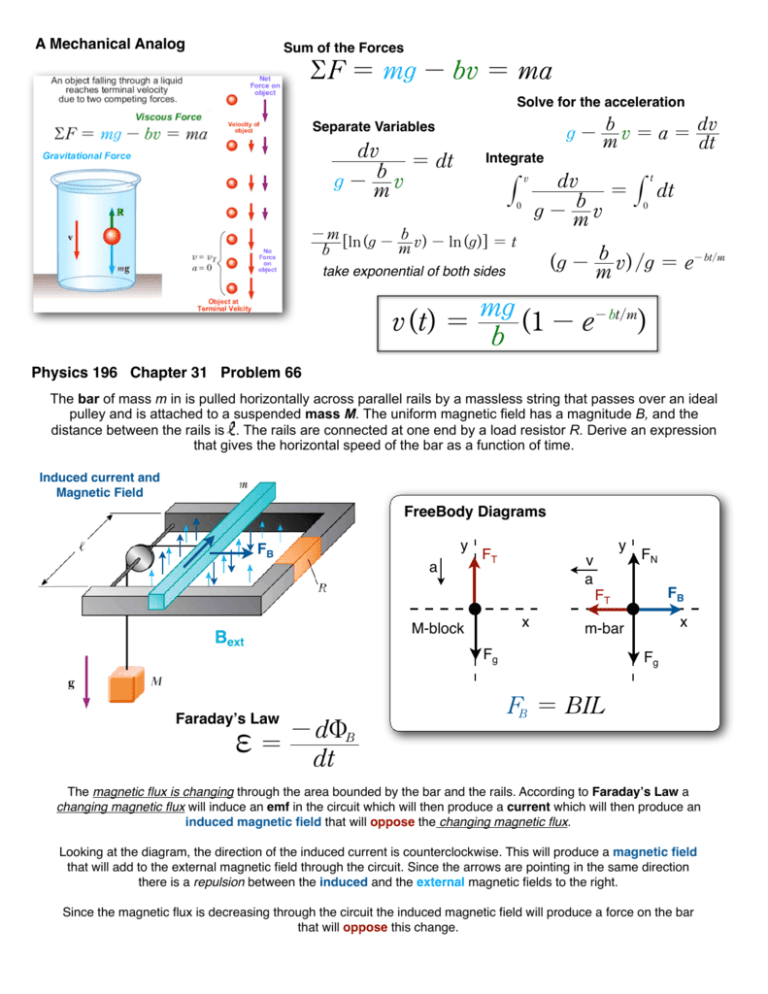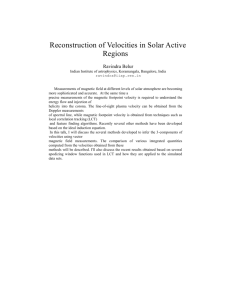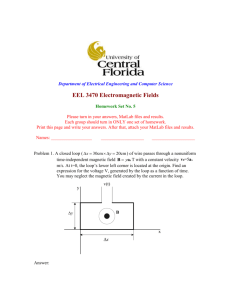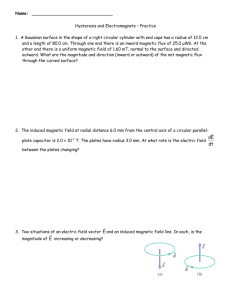v(t) = b mg (1 - e
advertisement

A Mechanical Analog Sum of the Forces RF = mg - bv = ma Solve for the acceleration b dv g- mv = a = dt Separate Variables dv = dt b g- mv Integrate # v 0 -m b [ln (g - m v) - ln (g)] = t b dv = b g- mv t dt 0 b (g - m v) /g = e-bt/m take exponential of both sides v (t) = # mg (1 - e-bt/m) b Physics 196 Chapter 31 Problem 66 The bar of mass m in is pulled horizontally across parallel rails by a massless string that passes over an ideal pulley and is attached to a suspended mass M. The uniform magnetic field has a magnitude B, and the distance between the rails is . The rails are connected at one end by a load resistor R. Derive an expression that gives the horizontal speed of the bar as a function of time. Induced current and Magnetic Field FreeBody Diagrams y FB a FT y v a FN FB FT x M-block Bext Fg Faradayʼs Law f = -dU dt x m-bar Fg FB = BIL B The magnetic flux is changing through the area bounded by the bar and the rails. According to Faradayʼs Law a changing magnetic flux will induce an emf in the circuit which will then produce a current which will then produce an induced magnetic field that will oppose the changing magnetic flux. Looking at the diagram, the direction of the induced current is counterclockwise. This will produce a magnetic field that will add to the external magnetic field through the circuit. Since the arrows are pointing in the same direction there is a repulsion between the induced and the external magnetic fields to the right. Since the magnetic flux is decreasing through the circuit the induced magnetic field will produce a force on the bar that will oppose this change. Sum of the Forces RFy = FT - Fg =-Ma y RFx = FB - FT =-ma x ay = ax Falling Mass FT = mg - Ma Sliding Bar FT = FB + ma Solve for the acceleration We need to find the induced magnetic force mg - Ma = FB + ma UB = BA cos i Iind f = dU = R d (BA) 1 d (Blw) 1 1 dw 1 Blv = = = Bl = R dt R dt R dt R dt R mg - FB = Ma + ma B 2 2 FB = BIind L = B ( Blv Blv )l = R R mg - FB =a M+m mg - FB dv = M+m dt Now, we are set to solve for the velocity of the bar with respect to time 2 2 mg Blv dv + = M+m dt R (M + m) Letʼs reduce our stress and set mg a= M+m b= Separate Variables 2 2 Bl R (M + m) dv mg B 2l 2 v + M+m R (M + m) = dt Integrate # 0 v dv = a - bv # t dt 0 -1 [ln (a - bv) - ln a] = t b ln (a - bv) - ln a =-bt (a - bv) /a = e-bt v (t) = a (1 - e-bt) b Over time, this magnetic force will balance with the gravitational force on the bar. This magnetic force is dependent upon the velocity of the bar. The bar will reach a terminal velocity once these two forces acting on the bar are equal. A Mechanical Analog Sum of the Forces RF = mg - bv = ma Solve for the acceleration b dv g- mv = a = dt Separate Variables dv = dt b g- mv # 0 Integrate v dv = b g- mv # t dt 0 2 pts b (g - m v) /g = e-bt/m 2 pts Solve for Velocity Physics 196 Chapter 31 Problem 66 The bar of mass m in is pulled horizontally across parallel rails by a massless string that passes over an ideal pulley and is attached to a suspended mass M. The uniform magnetic field has a magnitude B, and the distance between the rails is . The rails are connected at one end by a load resistor R. Derive an expression that gives the horizontal speed of the bar as a function of time. Draw Induced current, Magnetic Field and Mag-Force. FreeBody Diagrams 2 pts 3 pts y a Bext FT x M-block Fg Faradayʼs Law 1 pts The magnetic flux is changing through the area bounded by the bar and the rails. According to Faradayʼs Law a changing magnetic flux will induce an emf in the circuit which will then produce a current which will then produce an induced magnetic field that will oppose the changing magnetic flux. Looking at the diagram, the direction of the induced current is counterclockwise. This will produce a magnetic field that will add to the external magnetic field through the circuit. Since the arrows are pointing in the same direction there is a repulsion between the induced and the external magnetic fields to the right. Since the magnetic flux is decreasing through the circuit the induced magnetic field will produce a force on the bar that will oppose this change. Sum of the Forces RFy = FT - Fg =-Ma y 1 pts ay = ax Falling Mass Sliding Bar FT = mg - Ma 1 pts We need to find the induced magnetic force Set eqʼs equal and solve for the acceleration UB = BA cos i Iind 2 pts 2 pts f= = R 2 pts mg - FB =a M+m mg - FB dv = M+m dt Plug in FB and simplify. FB = BIind L = 2 pts Letʼs reduce our stress and set mg a= M+m b= 2 2 Bl R (M + m) Separate Variables 2 pts Draw the graph of the velocity wrt time. What is the terminal velocity? Show on the graph the velocity at e-2? 4 pts Integrate # 0 v dv = a - bv # t dt 0 2 pts (a - bv) /a = e-bt Solve for Velocity 2 pts






